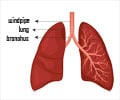
"Far too many patients continue to suffer preventable harm from these respirator-linked pneumonias," says study lead author Sean M. Berenholtz, M.D., M.H.S., an associate professor of anesthesiology and critical care medicine at the Johns Hopkins University School of Medicine. "Health care organizations need to be held accountable for ensuring that patients get safe and effective treatments to prevent these infections. Broad use of this intervention could prevent the vast majority of those 36,000 deaths."
Severely ill or injured intensive-care patients who can't breathe on their own need ventilators, but they're at serious risk for infections such as ventilator-associated pneumonia (VAP), which afflicts an estimated 250,000 patients each year. The risk of VAP increases about one to three percent for every day on a ventilator, Berenholtz says.
For the new study, caregivers in 127 ICUs at 82 hospitals in Michigan were instructed to use a group of evidence-based therapies for the prevention of VAP and other ventilator-related complications. The therapies, known as the ventilator bundle, became a checklist for caregivers to follow for patients on breathing machines.
The five therapies include elevating the head of the bed more than 30 degrees to keep bacteria from migrating into the lungs; giving antacids or proton pump inhibitors to prevent stomach ulcers; giving anticoagulants to prevent blood clots; lessening sedation to allow patients to follow commands; and daily assessment of readiness to remove the breathing tube. While only the first intervention specifically addresses bacteria that can cause pneumonia, all are designed to shorten the length of time on the ventilator a key to reducing risk of infection, the researchers say.
"If we evaluate patients every day with objective tests to see how well they are breathing on their own, patients will come off ventilators sooner," Berenholtz says. "And the less time they spend on the ventilator, the lower their risk of developing an infection."
Advertisement
The study encompassed data from 112 ICUs at 72 Michigan hospitals from October 2003 through September 2005 and then for up to 30 months after the checklist-implementation period. At the beginning of the study, the percentage of ventilator days on which patients received all five therapies was 32 percent. At 16-to-18 months post-implementation, the proportion rose to 75 percent and it was 84 percent at 28-to-30 months post-implementation.
Advertisement
Berenholtz's VAP research was conducted as part of the Keystone ICU Project, which also found that a cockpit-style checklist could virtually eliminate catheter-associated bloodstream infections in hospital intensive-care units throughout the state of Michigan, saving many lives and many millions of dollars. The results from that intervention have received widespread attention and are being replicated in hospitals across the country as more and more states adopt the Hopkins program.
"We hope that we can replicate these results nationally, reducing ventilator-associated pneumonia just as we have reduced bloodstream infections," says Peter J. Pronovost, M.D., Ph.D., a professor of anesthesiology and critical care medicine at the Johns Hopkins University School of Medicine and the VAP study's senior author.
Source-Eurekalert








